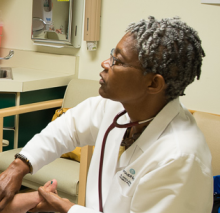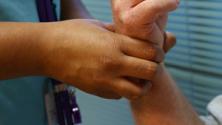Why is it important to rethink the role of the PCP?
Historically, primary care has been based on a model in which PCPs perform most clinical tasks. Today, however, it is increasingly difficult, if not impossible, for PCPs to do everything on their own. To meet the patient care expectations of a modern-PCMH, practices must routinely meet patient needs for evidence-based prevention and illness care, help patients become better managers of their health and illness, and monitor and support patients between clinic visits. PCMHs are expanding the comprehensiveness of their care to include the management of complex multi-problem patients, chronic pain, hepatitis C and HIV, and individuals with behavioral, mental health, or substance abuse problems. PCPs have also been burdened with increasing demands for documentation and administrative tasks. These increasing demands have understandably contributed to sub-optimal patient care, PCP frustration and professional burnout.
A team-based approach to primary care is gaining traction among innovative health care organizations and policymakers as a way to meet these escalating demands. Team-based care is most successful when PCPs learn to trust their staff and are able to work effectively both as team members and as team leaders.
How should the role of the PCP change?
Team-based care may often require PCPs to re-think their role in relationship to both their patients and other members of the primary care team. To work effectively in teams, PCPs need to:
• View themselves as team leaders or team members with lead responsibility for clinical decision making, but shared responsibility for overall patient care and panel management.
• Develop their capacity to lead a team and coach others to reach their full potential.
• Understand the roles and expertise of other team members, and support the goal that all team members work at the top of their license, training, and competence.
• Share power, control, and decision-making with others on the team.
• Move toward a culture of mutual respect and trust between PCPs and other staff.
• Develop systems that allow all team members to communicate effectively and efficiently about patient care needs.
• Look for opportunities to relinquish activities and tasks that do not require PCP-level medical knowledge, judgement, diagnostic skills, or decision making. Examples of these types of activities include health coaching, self-management goal setting, ordering routine labs, completing forms and documents, and transition management
Ultimately, the goal is to maximize the time PCPs have available for diagnosis, treatment, and building relationships with patients, while at the same time increasing job satisfaction and decreasing stress.
What do we gain by making these changes?
Changing to a team-based approach has many benefits for patients, PCPs, and the overall practice of primary care. The most important benefit is higher quality of care: studies have shown that collaborative and team-based approaches to care result in better patient outcomes. While some PCPs may initially be uncomfortable letting go of certain tasks, growing evidence suggests that more effective teams reduce PCP burnout and improve patient experience. Finally, our health care system as a whole will benefit from a sustainable model of primary care that attracts bright, motivated individuals at all levels of training.
- Assess what PCPs are currently doing in your practice
The first step toward building a team-based approach to care is to identify the specific tasks PCPs currently perform. This might require spending some time shadowing PCPs in their daily work or using other methods to detail all the tasks involved in a clinic day. This detailed documentation is important since PCPs may overlook routine tasks when describing their role. For example, PCPs may not think to account for tasks like diabetic monofilament exams, but tasks like this take time out of the clinical day and can be delegated to others.
- Build trust through co-location, increased communication, team building, quality improvement, and skills assessments
Practice teams work best when communication among teammates is frequent and timely. Strategies for building trust among team members include: a. Formal team building activities: Team building activities, such as using tools to help assess and discuss individual strengths and work styles (i.e. Myers-Briggs, Strengthfinder, etc.), getting training on effective team function, and organizing meetings to frankly discuss the challenges of working as a team. b. Co-location: When PCPs share work spaces with other members of their team, it facilitates strong communication among team members and helps build relationships and rapport. Co-location also allows team members to easily get answers to questions that may require other team members’ expertise. c. Increased communications: Huddles and other mechanisms for frequent communication such as protocols for instant messaging and/or calling PCPs and scheduling time for communication via short meetings and huddles in important to ensuring open communication and increasing trust. d. Test role changes: Having staff perform new tasks successfully on a few patients under observation helps the PCP and others feel more comfortable handing off work to individuals with less formal training (see Action Step 4). e. Agree on and document role and workflow changes: Team roles should be developed collaboratively and agreed upon by all team members to ensure shared understanding, and incorporated into work flows and job descriptions . Workflows that team members develop together can serve as both future training material and as the basis of formal skills assessments (see below). f. Formal skills assessments: Performing formal skills assessments of all staff periodically will identify areas of strength and opportunities for training and improvement. g. Involve PCPs in staff training, supervising, and supporting other team members: PCP involvement allows them to feel more comfortable delegating tasks.
- Decide which tasks and responsibilities can be transferred to non-PCP clinical staff
PCPs and their team should try to identify specific tasks that can be delegated to other members of the team and then explore ways to transfer responsibility for these tasks to them. This includes transferring ownership of both how the tasks are done and the outcomes that result. Formal methods of transferring oversight and responsibility include protocols and standing orders. Less formal approaches include communicating clear role expectations, assigning staff to be accountable for specific processes and metrics, and recognizing staff for improvements in processes and/or outcomes.
- Develop and test role changes and related processes and workflows
PCPs and their team should try to identify specific tasks that can be delegated to other members of the team and then explore ways to transfer responsibility for these tasks to them. This includes transferring ownership of both how the tasks are done and the outcomes that result. Formal methods of transferring oversight and responsibility include protocols and standing orders. Less formal approaches include communicating clear role expectations, assigning staff to be accountable for specific processes and metrics, and recognizing staff for improvements in processes and/or outcomes.
- Ensure roles changes decrease stress and increase job satisfaction for PCPs
Offloading tasks may cause PCPs to worry about losing the work that is less stressful or gives them the greatest satisfaction. This concern can even prevent them from fully embracing team-based care. It may be necessary to find ways for PCPs to retain some of the patient activities they value, such as well child checks, or but on a more limited scale or with a specific subset of patients. Also, PCPs schedules may need to be adjusted to accommodate schedules with a higher proportion of complex patients.
- Hire and retain the right people
Hiring and retaining the right individuals for each position on the team is critical. Having a clear job description with specific expectations for PCPs and all other members of the care team sets the standard for new people joining the team, and for evaluating existing staff. Whether hiring PCPs or other clinical staff, priority should be given to candidates with a willingness or even eagerness to innovate, be flexible, and hold a strong vision for how team-based care can improve the work environment for everyone on the care team. Being clear about the expectations for each member of the team will help you select the right person, and give individuals who do not subscribe to this model an opportunity to find a different practice model. You may also want to look for individuals who have specific experience and training working in teams and providing team leadership.
- 7. Provide training and support for PCPs
Providing training in communication, leadership, and team building may help PCPs become more effective team leaders. It’s also important to help PCPs find time to communicate and work with other team members outside of patient visits and to lead quality improvement initiatives
Video
Publications
Staff trainingTutorials, training manuals, etc.
ToolkitsImplementation guides and other documents with extensive resources included
LEAP Learning ModuleOther helpful topics included in this website
If you have a question about the improvements, action steps, or tools & resources in this module please let us know. We're here to help. And if we can't answer your question, we can probably connect you with someone who can.








